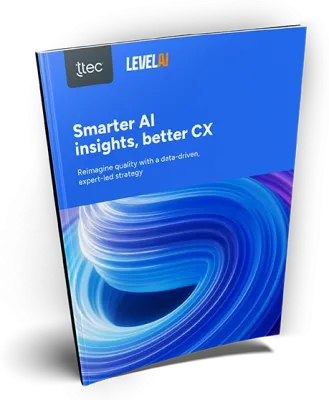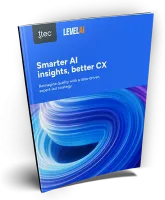These days, even if a customer care associate fails to notice that a caller is frustrated—the software analyzing the call doesn’t. As automated solutions like IVR and chatbots answer simple questions for customers, organizations are using AI-powered voice and real time speech analytics solutions to gain insights into the more complicated conversations that fall on customer care associates to resolve.
But while both voice and speech analytics provide insights into the voice of the customer (and are sometimes referred to interchangeably), their methods are different. We’ll explain what those differences are, the technology trends that impact them, and how to decide which analytics solution is right for your business.
Speech analytics vs. voice analytics
Speech analytics technologies are centered on the content of a conversation. The solutions are designed to analyze what was said by customers and associates, and in what context. This is achieved by converting speech into text or through phonetic indexing. The result is a searchable database of what associates and customers said during the conversations.
A customer, for instance, may make a phone call to a customer service line to complain about an erroneous charge on a bill. By executing a search for words spoken by the customer such as, “inaccuracy,” or “unexpected fee” along with a search for the associate saying “resolved” or “let me connect you” the reason for the customer interaction can be identified, as well as whether the customer received an answer to his or her question. By strategically pinpointing words and phrases used during a conversation, speech analytics help businesses make more informed decisions to improve quality assurance.
In contrast, whereas speech analytics analyzes what was said in a conversation, successful voice analytics focuses on how it was said. Voice analytics homes in on and scores certain qualities of a speaker’s voice, such as tone, pitch, and tempo to form an assessment, such as measuring the customer’s mood.
For example, a customer may use the word “fantastic,” but by recognizing cues, a voice analytics solution can determine that the customer is actually unhappy. The associate may then receive an alert on how to respond appropriately.
Harness real time speech analytics for improved insights into customer engagement
“The best solutions not only make it easier to extract more accurate insights and drive instant action through AI, but they also extend those capabilities by integrations with other systems,” according a Forrester report on AI-fueled speech analytics.
The research firm notes that AI has significantly ramped up the capabilities of real time speech analytics solutions, such as by improving speech-to-text accuracy, insight generation, quality management, and measurement of tone and sentiment. Indeed, there are multiple ways for agents and supervisors to leverage AI-powered speech and voice analytics to improve customer experiences and the overall customer journey. Here are a few examples:
- Fraud detection: AI combined with speech analytics tools can be trained to assess and score calls for potential fraud and alert associates before they release confidential customer information.
- Mitigate liability risks and compliance issues:Using real-time speech analytics, associates can receive reminders about required disclosures that they must share before ending the conversation.
- Greater insights about customer satisfaction: Some solutions use deep learning—a type of AI that utilizes neural nets to deliver better insights—for emotion detection or to extract insights from speech.
- Predict NPS scores: Integrating net promoter score (nps) results with predictive and speech analytics allows companies to predict customer expectations and responses.
- Guided recommendations: Using real-time speech and/or voice analytics, associates can receive guidance to recommend relevant products or offers to the customer—or not, depending on the customer’s mood and the nature of the call.
- Associate training: Similarly, real-time voice analytics enables managers to monitor calls and identify opportunities to provide coaching or support.
- Self-managed learning: Post call speech analytics can also increase employee engagement, by giving associates fast access to insights about their call performance. Associates can track their own performance and make adjustments, which speeds up the learning and training process.
Which real time voice of the customer (VOC) solution is the best fit for your business and customer experience program?
Now that you have a better understanding of speech and voice analytics trends, you may be wondering which one would be the best fit for your company’s needs. Identifying your business needs and the scope and goals of the project will help determine which type of solution to pursue. Here are several key questions to consider before meeting with a vendor or consultant:
- What is the volume of calls that you want to analyze?
- What do you hope to gain? For example, are you trying to understand the caller’s temperament or reason for calling, or both?
- Are you looking for a tool to monitor script compliance?
- Do you plan to integrate the findings from voice calls with other analytics, platforms, or channels?
- How will the project’s success be measured?
Overall, while many companies understand the importance of a voice of the customer strategy, most only manage to react to negative sentiment on an individual case level. The more transformative approach is to use the power of AI powered, real time speech analytics to implement proactive modeling and analytical tools to decipher customer data and respond before discontent becomes an actual customer complaint. By analyzing VOC data, companies can drive significant improvements in processes, products, and interaction points.
Contact center agents have access to more customer data than ever before. Combined with artificial intelligence, voice and speech analytics make it possible for associates to provide callers with the right information at the right time—and even predict the customer’s reaction. And while there are many speech, voice, and text analytics tools to choose from, the best ones are unnoticeable. They allow associates to focus on what they do best, engaging customers in a human conversation.
More content on how real time voice of the customer insights power CX and digital transformation
We hope you enjoyed this article on how to harness the power of real time speech analytics to create a more effective and strategic voice of the customer program. To explore voice of the customer and speech analytics topics in more detail, we have many other articles and resources. For example, in VOC Analytics: 5 To-Dos in the New Era of Data read about emerging trends and ways to modernize your VOC program so it provides real time voice of the customer data. In our Voice of the Customer Strategy and Best Practices article, we dispel four common VOC myths and explain how to incorporate mobile best practices into your customer data strategy. In Make Every Voice Heard With Speech Analytics, we look at 4 ways your contact center can turn data insights into action to foster growth, enhance the customer’s journey, and train associates faster and more effectively. And finally, in our cheat sheet, 5 Ridiculously Simple Ways to Get the Most Out of Your Speech Analytics, we outline how speech analytics tools can augment employee experience on the floor and customer experience over the phone.
Also, to learn more about TTEC's CX Analytics capabilities, please visit our Voice of the Customer and Speech Analytics Solutions pages.















